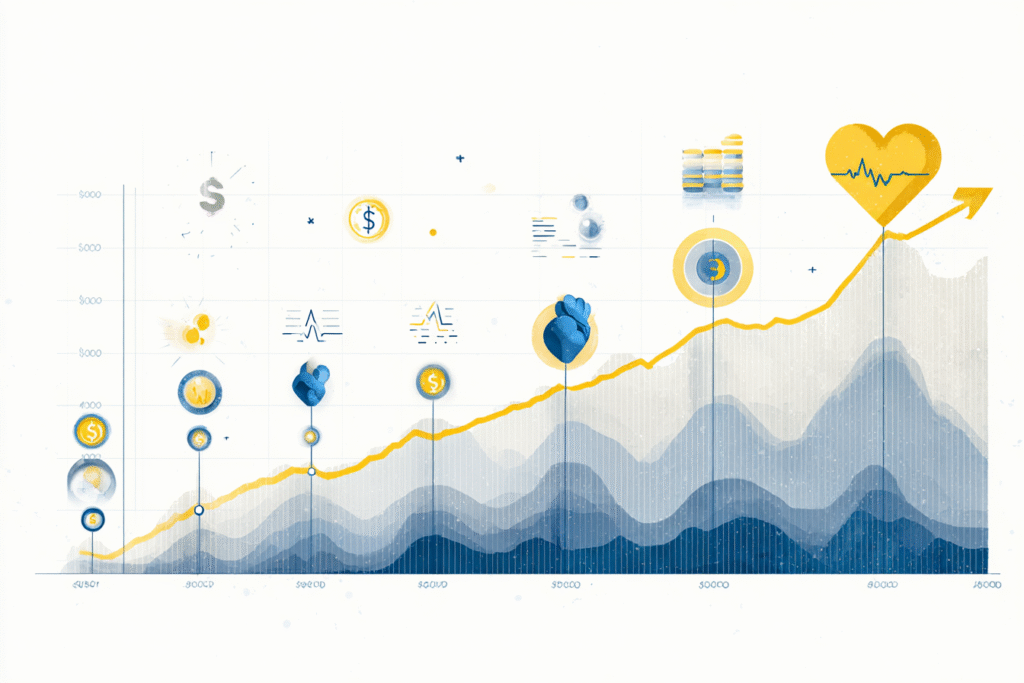The most powerful health interventions cost nothing to implement.
Note: This article is for educational and informational purposes only. See full disclaimer at the end.
You don’t need a premium gym membership, the latest wearable tech, or a concierge doctor to optimize your health.
What you need is strategic thinking, resourcefulness, and the knowledge that prevention isn’t a luxury—it’s an investment anyone can make.
In a time when healthcare costs are soaring and inequality continues to grow, this truth has never mattered more.
The myth that effective health optimization requires significant financial resources keeps millions from taking control of their wellbeing.
Today, we’re dismantling that barrier by creating your comprehensive guide to accessible health optimization across every budget level.
The Economics of Accessible Prevention
Health optimization operates on a simple economic principle: the earlier you invest, the greater your returns, regardless of the size of your initial investment. Research consistently demonstrates that preventive interventions provide exceptional returns on investment across all economic levels.
A comprehensive meta-analysis examining workplace wellness programs found that medical costs fall by approximately $3.27 for every dollar spent on prevention initiatives [1]. More importantly for individual optimization, many of the most effective preventive measures cost virtually nothing to implement while delivering substantial health dividends.

The World Health Organization’s analysis of cost-effective health interventions for low- and middle-income populations identified numerous interventions costing less than $200 per disability-adjusted life year (DALY) averted [2]. These findings translate directly to individual health optimization:
The most powerful interventions are also the most universally available.
Consider the fundamental four prevention pillars that form the foundation of health optimization:
Physical Activity: Walking 30 minutes daily costs nothing but provides cardiovascular benefits equivalent to many expensive medical interventions. Increasing physical activity could prevent over 100,000 deaths each year, according to CDC estimates [3].
Nutrition Optimization: Basic nutritional improvements through strategic food choices and preparation methods can dramatically improve health outcomes without requiring expensive supplements or specialized products.
Stress Management: Evidence-based stress reduction techniques, including meditation and breathing exercises, require no equipment yet provide measurable physiological benefits including reduced blood pressure and improved immune function.
Sleep Optimization: Quality sleep hygiene practices require zero financial investment but provide returns comparable to expensive medical treatments for numerous conditions.
The key insight: prevention accessibility isn’t determined by available resources—it’s determined by strategic resource allocation and informed decision-making.
The Universal Prevention Foundation
Regardless of your current financial situation, certain prevention strategies remain universally accessible and extraordinarily effective. These form your foundation for health optimization at any economic level.

Movement as Medicine
Physical activity represents the most cost-effective health intervention available, with research consistently demonstrating that regular movement prevents more disease than most pharmaceutical interventions while costing significantly less.
The Walking Revolution: Walking remains the most accessible form of exercise, requiring only functional mobility and basic footwear. Research from Harvard Health demonstrates that brisk walking for 20-30 minutes daily reduces the risk of heart disease by approximately 30% [4].
Strategic walking optimization includes:
- Interval Integration: Alternate between moderate and brisk pacing to maximize cardiovascular benefits
- Environmental Utilization: Use stairs, longer routes, and walking meetings to accumulate daily movement
- Social Multiplication: Group walking provides accountability while creating social connection—both powerful health drivers
Bodyweight Training: Calisthenics and bodyweight exercises provide comprehensive strength training without equipment costs. Research demonstrates that bodyweight training produces strength gains comparable to traditional weightlifting while improving functional movement patterns [5].
Effective bodyweight routines include push-ups, squats, planks, and lunges—exercises that target all major muscle groups and can be performed anywhere. Progressive overload occurs through repetition increases, longer holds, or movement variations rather than external weight additions.
Community Resource Utilization: Most communities provide free or low-cost physical activity resources including parks, basketball courts, swimming facilities, and walking trails. Many cities offer free fitness classes through recreation departments. These sessions include professional instruction and foster community without membership costs.

Nutritional Optimization on Any Budget
Nutrition represents another area where strategic thinking trumps financial resources in achieving health optimization. The most powerful nutritional interventions focus on food preparation methods, timing, and combination rather than expensive supplements or specialty products.
Foundational Nutritional Strategies:
Batch cooking reduces both cost and decision fatigue. It also supports consistency by creating multiple meals from a single prep session.
Preparing large quantities of basic proteins, vegetables, and whole grains creates a foundation for multiple meals while maximizing time and resource efficiency.
Seasonal and Local Optimization: Purchasing seasonal produce provides optimal nutrition at reduced costs while supporting local food systems. Frozen vegetables often provide superior nutrition to out-of-season fresh options while maintaining significant cost advantages.
Hydration Excellence: Water remains the optimal beverage for health while being essentially free. Proper hydration supports every physiological system while replacing expensive beverages full of empty calories or artificial stimulants.
Just as strategic nutrition builds your biological foundation, managing mental stress reinforces it—supporting every other system in your body.
Stress Management and Mental Health
Mental health optimization through stress management provides extraordinary returns on investment while requiring no financial outlay. Chronic stress contributes to virtually every chronic disease while stress management techniques provide measurable physiological improvements.
Evidence-Based Stress Reduction:
Breathing Techniques: Deep breathing exercises activate the parasympathetic nervous system, reducing cortisol levels and blood pressure within minutes. The 4-7-8 breathing technique (inhale for 4, hold for 7, exhale for 8) provides immediate stress relief and can be practiced anywhere.
Meditation and Mindfulness: Research demonstrates that regular meditation practice reduces anxiety, depression, and chronic pain while improving immune function and cognitive performance [6]. Free meditation apps and online resources provide guided instruction without requiring classes or equipment.
Nature Integration: Time spent in natural environments provides measurable stress reduction and mood improvement. Even urban green spaces provide these benefits, making nature exposure accessible regardless of location.

Technology Integration Across Budget Levels
Health technology can enhance optimization efforts across all budget levels, from free smartphone apps to comprehensive monitoring systems. The key lies in strategic technology selection based on individual needs and resources.
Free and Low-Cost Digital Tools
Smartphone Integration: Modern smartphones provide sophisticated health tracking capabilities through built-in sensors and free applications. Step counting, activity tracking, and basic health monitoring require no additional equipment while providing valuable feedback.
Educational Resources: Free online resources provide access to evidence-based health information, workout routines, and nutritional guidance. YouTube, health department websites, and academic institutions offer comprehensive educational content at no cost.
Community Apps: Digital platforms connect individuals with local health resources, walking groups, and community activities, facilitating social connection and mutual support in health optimization efforts.
Mid-Range Technology Optimization
For those with moderate technology budgets, strategic equipment purchases can significantly enhance health optimization efforts while maintaining cost-effectiveness.
Blood Pressure Monitoring: Home blood pressure monitors provide crucial health data for approximately $50-100, enabling early detection of hypertension and monitoring of cardiovascular health improvements [7]. The American Heart Association recommends home monitoring for all individuals with high blood pressure to track treatment effectiveness.
Basic Fitness Equipment: Resistance bands, yoga mats, and adjustable dumbbells provide comprehensive exercise options for under $200, creating a functional home gym that supports long-term fitness goals. Used equipment often provides excellent value while reducing initial costs.
Wearable Technology: Fitness trackers and smartwatches provide continuous activity monitoring, sleep tracking, and basic health metrics. While not essential for health optimization, these devices can provide motivation and feedback that enhance adherence to healthy behaviors.
While not essential, higher-end tools can offer deeper insights and increased automation for those pursuing advanced health goals or managing complex conditions.

Premium Health Technology
For individuals with larger technology budgets, advanced monitoring and optimization tools can provide additional insights and convenience while supporting comprehensive health management.
Advanced Health Monitoring: Comprehensive health monitors that track multiple biomarkers, sleep quality, and recovery metrics provide detailed feedback for optimization efforts. These tools are particularly valuable for individuals managing chronic conditions or pursuing advanced fitness goals.
Smart Home Integration: Connected devices that monitor air quality, adjust lighting for circadian rhythm optimization, and automate healthy behaviors can create an environment that supports health optimization with minimal daily effort.
Healthcare System Navigation
Understanding how to navigate the healthcare system effectively represents a crucial skill for health optimization across all economic levels. Strategic healthcare utilization maximizes prevention while minimizing costs.
Insurance Optimization
The Affordable Care Act requires most health insurance plans to cover preventive services without cost-sharing, providing significant value for policy holders [8]. Understanding these benefits enables strategic healthcare utilization.
Free Preventive Services: Most insurance plans must cover numerous preventive services including vaccinations, cancer screenings, cardiovascular screenings, and preventive counseling without deductibles, copayments, or coinsurance.
Annual Wellness Visits: Many plans provide comprehensive annual physical exams and health risk assessments at no cost, providing professional health evaluation and early problem detection.
Specialist Referrals: Understanding referral processes and prevention-focused specialists can provide access to specialized care when needed while maximizing insurance benefits.

Community Health Resources
Community health centers provide comprehensive healthcare services regardless of ability to pay, serving as crucial resources for individuals without insurance or with limited financial resources [9].
Federally Qualified Health Centers (FQHCs): These centers provide primary care, dental services, mental health care, and preventive services on a sliding fee scale based on income. Over 1,400 health centers serve 30 million patients annually, making them widely accessible resources.
Free and Charitable Clinics offer no-cost healthcare to the uninsured. These community-run clinics serve as a vital safety net [10].
Public Health Departments: Local health departments often provide free or low-cost preventive services including immunizations, health screenings, and health education programs.
Once you understand how to leverage insurance and local resources, the next step is to implement a smart screening plan that fits your budget and goals.
Health Screening Optimization
Strategic health screening utilizes both insured benefits and community resources to maintain comprehensive health monitoring without excessive costs.
Essential Screening Schedule: Understanding which screenings are recommended at what ages enables strategic scheduling that maximizes early detection while minimizing redundancy.
Community Screening Events: Many organizations sponsor free health screening events providing blood pressure checks, cholesterol testing, diabetes screening, and other basic health assessments.
Home Monitoring Integration: Combining professional screenings with home monitoring creates comprehensive health surveillance while reducing healthcare visits and associated costs.
Building Your Accessible Health Optimization System
Creating a sustainable health optimization system requires systematic integration of prevention strategies, resource utilization, and progress monitoring regardless of available budget.

The Foundation Protocol
Daily Movement Integration: Establish non-negotiable daily movement through walking, bodyweight exercises, or activity integration into existing routines. Start with 20-30 minutes daily and build consistency before increasing intensity or duration.
Nutritional Framework: Implement meal preparation systems, hydration optimization, and strategic food purchasing to maximize nutritional quality while managing costs. Focus on whole foods, batch cooking, and seasonal purchasing for optimal cost-effectiveness.
Sleep Architecture: Establish consistent sleep schedules, optimize sleep environment through free methods (darkness, temperature, quiet), and implement sleep hygiene practices that require no equipment or cost.
Stress Management Systems: Integrate daily stress management through breathing exercises, brief meditation, nature exposure, or other evidence-based techniques that fit individual schedules and preferences.
Resource Scaling Strategy
Assessment Phase: Evaluate current health status, available resources, and optimization goals to create personalized prevention priorities. Focus on areas with the highest impact and lowest barriers to implementation.
Progressive Implementation: Begin with free, universal interventions and gradually add resource-dependent optimizations as budget allows. This approach ensures continuous progress while preventing financial strain.
Community Integration: Identify local resources, support systems, and opportunities for social connection around health optimization. Community involvement enhances adherence while often reducing costs through group activities and mutual support.
This systematic approach builds naturally on the monitoring framework we established in our previous insight, transforming health surveillance from reactive crisis management into proactive optimization.
Where monitoring helps you detect problems early, these accessible interventions help you prevent them entirely.

Measurement and Adaptation
Outcome Tracking: Monitor key health indicators through a combination of professional assessments, home monitoring, and subjective wellness tracking. Focus on trends rather than daily fluctuations to maintain motivation and accurate assessment.
System Refinement: Regularly evaluate and adjust optimization strategies based on results, changing circumstances, and available resources. Flexibility in approach maintains long-term sustainability while accommodating life changes.
Resource Optimization: Continuously seek new resources, technologies, and strategies that improve cost-effectiveness while enhancing health outcomes. Health optimization evolves with available tools and knowledge.
Where should you begin?
Three Starting Points: $0, $50, $500
To help you begin immediately, here’s how to start at any budget level—from completely free to strategic technology investment.
$0 Investment:
Daily walk (20–30 mins)
Batch cooking whole foods
4-7-8 breathing, 2x/day
Fixed sleep schedule
Use free local parks + health resources
$50 Investment:
Resistance bands or yoga mat
Basic blood pressure monitor
Download a meditation app with premium features
$500 Investment:
Fitness tracker or smartwatch
Adjustable dumbbells
Air quality monitor
Circadian light system
The Long-Term Investment Perspective
Health optimization represents the ultimate long-term investment, providing compounding returns that increase over time regardless of initial investment size. The earlier you begin and the more consistent your efforts, the greater your lifetime returns.

Research from the Centers for Disease Control and Prevention demonstrates that every dollar invested in evidence-based prevention programs yields $5.60 in healthcare cost savings [11]. More importantly, prevention investments provide returns in quality of life, productivity, and longevity that extend far beyond financial considerations.
The accessibility of prevention means that health optimization remains available to everyone willing to invest time, attention, and strategic thinking into their wellbeing. Your health optimization system grows more sophisticated and effective over time, but it begins with simple, accessible interventions that cost nothing to implement.
Prevention accessibility isn’t about having perfect resources—it’s about making consistent, informed decisions that compound over time.
Whether you’re starting with zero dollars or scaling with smart tech, the most important step is the first one you take today.
Your body doesn’t need perfection. It needs momentum. And the most powerful optimizations are already within reach.
See you in the next insight.
Comprehensive Medical Disclaimer: The insights, frameworks, and recommendations shared in this article are for educational and informational purposes only. They represent a synthesis of research, technology applications, and personal optimization strategies, not medical advice. Individual health needs vary significantly, and what works for one person may not be appropriate for another. Always consult with qualified healthcare professionals before making any significant changes to your lifestyle, nutrition, exercise routine, supplement regimen, or medical treatments. This content does not replace professional medical diagnosis, treatment, or care. If you have specific health concerns or conditions, seek guidance from licensed healthcare practitioners familiar with your individual circumstances.
References
The references below are organized by study type. Peer-reviewed research provides the primary evidence base, while systematic reviews synthesize findings across multiple studies for broader perspective.
Peer-Reviewed / Academic Sources
- [1] Baicker, K., Cutler, D., & Song, Z. (2010). Workplace wellness programs can generate savings. Health Affairs. 29(2):304-311. https://www.healthaffairs.org/doi/10.1377/hlthaff.2009.0626
- [2] Verguet, S., Jamison, D.T., et al. (2015). Ranking 93 health interventions for low- and middle-income countries by cost-effectiveness. PLoS One. 10(8):e0135455. https://www.ncbi.nlm.nih.gov/pmc/articles/PMC5552255/
- [3] Saint-Maurice, P.F., Troiano, R.P., et al. (2020). Association of daily step count and step intensity with mortality among US adults. JAMA. 323(12):1151-1160. https://jamanetwork.com/journals/jama/fullarticle/2763292
- [4] Elson, L. (2023). Revitalize your walking routine. Harvard Health Publishing. https://www.health.harvard.edu/heart-health/revitalize-your-walking-routine
- [5] Thomas, E., Bianco, A., et al. (2017). The effects of a calisthenics training intervention on posture, strength and body composition. Isokinetics and Exercise Science. 25(3):215-222. https://www.researchgate.net/publication/317321468_The_effects_of_a_calisthenics_training_intervention_on_posture_strength_and_body_composition
- [6] Le, L.K., Esturas, A.C., et al. (2021). Cost-effectiveness evidence of mental health prevention and promotion interventions: A systematic review of economic evaluations. PLoS Medicine. 18(5):e1003606. https://pmc.ncbi.nlm.nih.gov/articles/PMC8148329/
- [7] Shimbo, D., Artinian, N.T., et al. (2020). Self-measured blood pressure monitoring at home: a joint policy statement from the American Heart Association and American Medical Association. Circulation. 142(4):e42-e63. https://www.ahajournals.org/doi/10.1161/CIR.0000000000000803
Government / Institutional Sources
- [8] Centers for Medicare & Medicaid Services. (2010). Background: The Affordable Care Act’s New Rules on Preventive Care. CMS.gov. https://www.cms.gov/cciio/resources/fact-sheets-and-faqs/preventive-care-background
- [9] Kaiser Family Foundation. (2025). Community Health Center Patients, Financing, and Services. KFF. May 13, 2025. https://www.kff.org/medicaid/issue-brief/community-health-center-patients-financing-and-services/
- [10] National Association of Free & Charitable Clinics. (2024). Find a Clinic. NAFC. March 27, 2024. https://nafcclinics.org/find-clinic/
- [11] Backman, D.R., Kohatsu, N.D., et al. (2015). Health Promotion Interventions for Low-Income Californians Through Medi-Cal Managed Care Plans, 2012. Preventing Chronic Disease. 12:150269. https://www.cdc.gov/pcd/issues/2015/15_0269.htm


